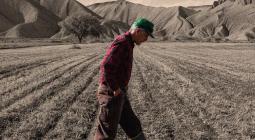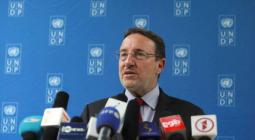Chilli peppers, coffee, wine: how the climate crisis is causing food shortages
Blistering heat, stronger storms, droughts, floods and fires are putting food production at risk
Sriracha fans are a passionate bunch. They have been known to get tattoos of the popular hot sauce on their bodies and dress up like the red plastic squeeze bottle for Halloween.
So it’s no surprise that an unprecedented shortage of the beloved condiment would send loyalists scrambling to avoid a spiceless summer.
Huy Fong Foods, the southern California company that produces 20m bottles of sriracha annually, has experienced a low inventory of red jalapeño chilli peppers in recent years made worse by spring’s crop failure.
The cause? Severe weather and drought conditions in Mexico.
It’s not just chilli peppers. Mustard producers in France and Canada said extreme weather caused a 50% reduction in seed production last year, leading to a shortage of the condiment on grocery store shelves. Blistering heat, stronger storms, droughts, floods, fires and changes in rainfall patterns are also affecting the cost and availability of staples, including wheat, corn, coffee, apples, chocolate and wine. The climate crisis is increasing the intensity and frequency of extreme weather events – and it’s putting food production at risk.
“Almost everything we grow and raise in the US is facing some climatic stress,” said Carolyn Dimitri, nutrition and food studies professor at NYU.
Wheat and other grain crops are particularly vulnerable. In the Great Plains, where most of the US’s wheat is harvested, drought depressed the winter crop. Abandonment levels for winter wheat in the US – primarily in Texas and Oklahoma – are the highest since 2002. Meanwhile in Montana, flooding is threatening grain crops.
“This becomes important because the US doesn’t have a large surplus and can’t really contribute at this exact minute to fill in the global gap in wheat supplies due to the Ukraine crisis,” said Dimitri.
The impact of the climate crisis on grain crops extends beyond the US. In India, a fierce heatwave damaged the wheat crop due to record-setting temperatures throughout the spring and summer. As Delhi hit 120F in May, the government placed a ban on wheat exports, driving up prices even further than the rise following Russia’s invasion of Ukraine.
Climate change could seriously affect the global production of maize and wheat as early as 2030, a 2021 Nasa study found, with maize crop yields estimated to decline by 24%.
Apples are another food already at risk. Last year’s apple harvest in Michigan and Wisconsin was compromised because of heavy frost in the spring. According to the USDA, changes in climate, such as warming, can lead to smaller yields, lower growth and changes in the fruit’s quality.
“Humans are scrappy little creatures so we’re still growing food and yields are going up by and large, but as the temperature goes up, the challenge becomes greater,” said Ricky Robertson, a senior researcher at International Food Policy Research Institute.
Extreme weather is affecting the cost of coffee. Between April 2020 and December 2021, coffee prices increased 70% after droughts and frost destroyed crops in Brazil, the world’s largest coffee-producing country. The economic ramifications could be profound, since it’s estimated that as many as 120 million of the world’s poorest depend on coffee production for their survival.
John Furlow, director of the Columbia Climate School’s International Research Institute for Climate and Society (IRI), said coffee farmers in places like Costa Rica and Jamaica can’t just move to higher elevations in response to warming temperatures.
“Think of a mountain as a cone,” said Furlow. “As you move up there’s less area, so that’s a risk.”
The climate crisis will also change where farmers can grow cacao and a shortage of chocolate products is expected in the coming years due to drier weather in west Africa.
Last year, France’s wine industry saw its smallest harvest since 1957, with an estimated loss of $2bn in sales. One Champagne vineyard that typically makes 40,000 to 50,000 bottles annually produced nothing in 2021 due to higher temperatures and heavy rains.
One study showed that if temperatures rise by 2C, wine-growing regions could shrink by as much as 56%. Four degrees of warming could mean 85% of those areas would no longer be able to produce good wines.
“This means that growers are having to increase irrigation – a soon-to-be non-viable adaptation strategy – migrate or cease production entirely,” said Linda Johnson-Bell, founder of the Wine and Climate Change Institute.
“Climate change and its erratic weather patterns will change the world’s wine map. Regions will disappear and others will emerge.”
California’s record-setting wildfires in 2020 severely affected harvest and the hazardous air quality threatened large portions of the state’s wine grape crop. Napa Valley winemakers are being forced to take extreme action, such as spraying sunscreen on grapes and irrigating with treated wastewater from toilets and sinks, in order to survive – and some vineyards won’t.
Robertson likens agriculture’s climate-related challenges to a game of musical chairs, with growers having to move their production in order to adapt to warmer temperatures and extreme weather.
“You’re going to have to work harder and find more land to grow,” he said. “The places that become less good for growing stuff are greater than the new places they can go. The small producers especially are going to face difficulty in trying to figure out where they are in the musical chairs.”
Food production is a driver of the climate crisis and a victim of it. Transforming the food system will require a slew of actions, including increasing crop diversity, delivering climate predictions to farmers around the world, expanding conservation programs and offering growers insurance that pays out when an index such as rain or wind speed falls above or below a set threshold.
The Biden administration is supporting research into “climate-smart” agriculture, an approach to managing cropland, forest, fisheries and livestock that attempts to address the intersecting challenges of the climate crisis and food security.
In May, the UN secretary general, António Guterres, said that climate-related disasters and extreme weather were a driver of global hunger and that 1.7 billion people have been affected by the climate crisis over the last decade.
Experts say unless action is taken, we can expect to see increased food prices, decreased availability and conflict over water, which will primarily affect poorer countries and low-income Americans, straining everything from school lunches to food aid programs.
“We’re suffering in the US because we can’t get sriracha,” said Furlow. “The farmers who produce those peppers are not getting that income – that’s a little bit worse than having a bland sandwich.”
Victoria Namkung




